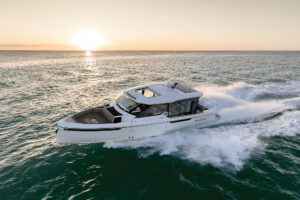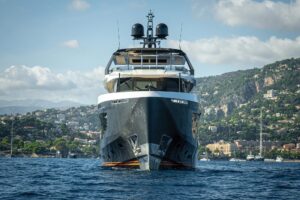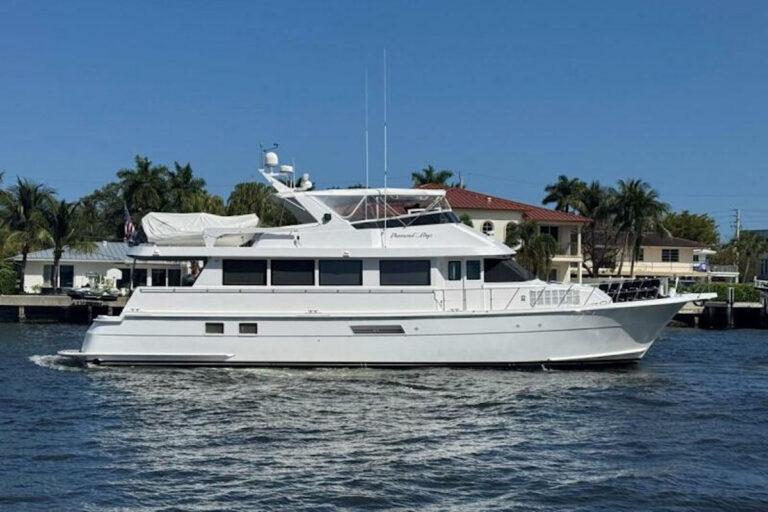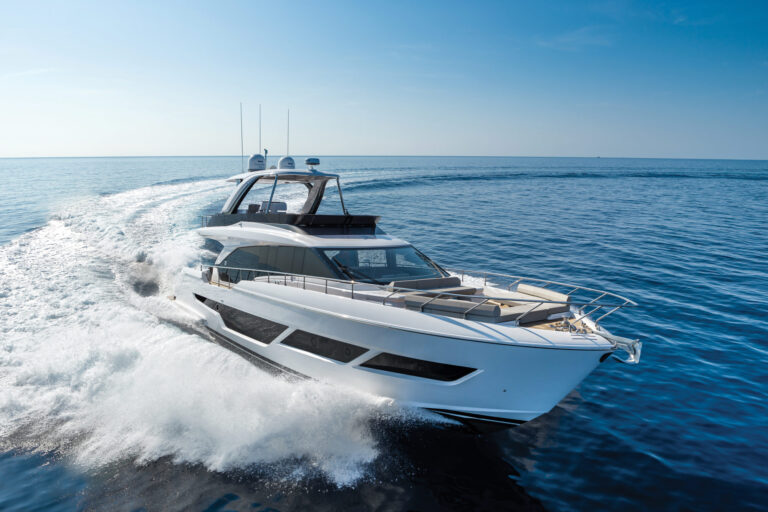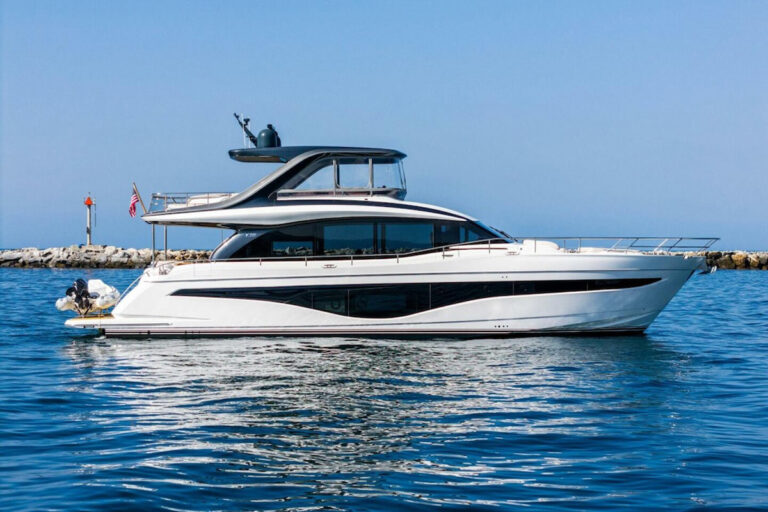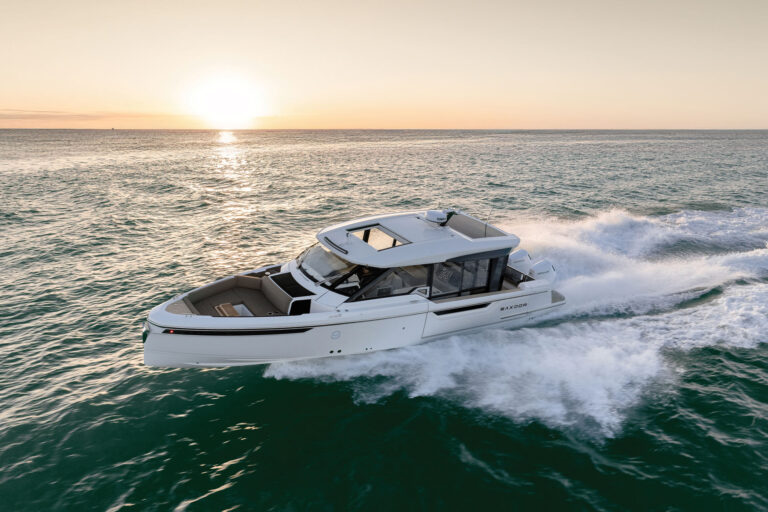Silverton has been building boats in New Jersey since lapstrake sea skiffs were in fashion. When the Luhrs brothers (John and Warren) took the helm in 1969, the company blossomed from a small, regional builder into a major marque. Today, Silverton builds a range of designs focused on family cruising. Even so, in my view the Sport Bridge lineup is its most unique offering.
That’s one reason why I had been looking forward to the introduction of the 43; another is that I had reviewed her 38-foot sibling and then watched her go on to become one of Silverton’s top-selling models. The 43 replaces a 41-footer and is the largest Sport Bridge to date. While Silverton’s design team did a splendid job wrapping the 38’s full-beam interior in an attractive package, the 43’s styling is more balanced and the look is lower and leaner to my eye. Silverton promotes Sport Bridge styling as “European, however, as I suggested with the 38, there is no reason to share credit. Rakish profiles and sweeping window lines are not proprietary features and the way Silverton’s design team has blended them together is distinctive and pleasing (OK, you can call it international styling if you like). I do concede that the 43’s sponson-like wraparound transom platform is foreign and as it stands proud of her hull, care must be taken when navigating a tight slip.
What Silverton refers to as an “American arrangement is the foundation of the Sport Bridge concept. This translates into open space, large comfortable seating and a foot-friendly traffic pattern that makes moving about the boat easy. Silverton’s clever “SideWalk design allows for a full-beam main cabin without compromising access fore and aft. These are essentially side decks, integrated into the styling, that join the bridgedeck and the foredeck (molded-in steps lead to the afterdeck). The arrangement maximizes bridge space as well and to good effect: There is a stylish control station here with helm and companion seating. A nearby lounge area includes a sunpad and a wet bar that can be fitted with a refrigerator.
Below, there is enough room on the afterdeck for a couple of chairs and a niche for an icemaker. Access to the lazarette area is through a guttered hatch; a gate leads to a swim platform that could accommodate a small tender. The foredeck’s sunpad will please the sybarites, while Master and Commander types will appreciate how ground tackle and windlass are hidden under a deck hatch-no anchor pulpit is required. The rakish bowrail extends forward of the deck perimeter and seems a bit of a reach; however, I’m sure it would become familiar given time. All stainless steel fabrication is done in-house.
A curved sliding glass door leads to the cabin. Windows provide plenty of natural light while side vent windows deliver fresh air. The seating area aft has a domestic-style sofa that converts to a double berth and a curved sofa with internal drawer storage or optional dual recliners. An entertainment center includes a 20-inch flat-panel TV on a lift that rises from a cabinet with the push of a button. Forward, it is a step up to the dinette area and a step down to the galley. The dinette could seat four full-beam Americans comfortably; the galley, fitted with a cook top, has a convection oven/microwave, and dual-voltage refrigeration. The master stateroom is forward and has a queen-size island berth. There is drawer and cabinet storage under the berth as well as two cedar-lined hanging lockers. The private master head is a split arrangement (head/shower). A guest stateroom tucks beneath the dining area, with a second head in the passageway.
Like many production boatbuilders, Silverton has invested in touch and feel, upgrading its interior standards in response to heightened customer expectations. The 43’s semigloss cherry interior is a good example. Cabinets have concealed European hinges and drawers have solid cherry faces and birch plywood interiors. The galley has Corian counters, a polished stainless steel sink and a durable faux wood sole. The dinette has a solid cherry table with a high-gloss finish. Silverton offers an interior dÈcor package that features designer soft goods and accessories. All of Silverton’s cabinet and upholstery work is done in-house. Computer-controlled routers and saws are used for cutting wood and all joints are screwed and glued.
Like all Silverton products, the 43’s design was modeled on computer and mocked up prior to production. A five-axis router was used to cut plugs for the hull and superstructure tooling. The net result is that the 43’s complicated exterior styling flows smoothly and her gelcoat finish is near perfection. The hull is handlaid with woven roving; Coremat is used to increase thickness and minimize print-through, while a vinylester-resin skin coat is laid on below the waterline to reduce the chance of blistering. Stringers and web frames are pressure-treated plywood encapsulated in fiberglass, and the decks and portions of the superstructure are stiffened with balsa coring. The 43’s interior is built in modular fashion and installed in the hull prior to its mating with the superstructure. The hull/deck joint is bonded and bolted. The joint is also fiberglassed where accessible. Silverton’s new five-year warranty is standard.
Hatches in the cabin sole allow access to the engineroom. By lifting the two middle hatches you can descend the ladder and move about the space on centerline, performing basic preflight checks on the engines and generator. The compartment is well lit and bilge areas are finished with gelcoat. The engines are mounted on powder-coated steel I-beams that are bolted to the forward engineroom bulkhead and a stout web frame aft. This arrangement is proven and makes sense from a production standpoint as it simplifies engine alignment. Some feel it also allows for better transmission of thrust to the hull structure while at the same time making it possible to better isolate engine noise and vibration. The setup seems to work on the 43: I noted virtually no vibration and pleasantly low sound levels at speed.
The 43 has a moderate entry with strakes to control spray. Her after sections terminate with a transom deadrise of 17 degrees and propeller pockets help trim her draft to a modest 3 feet, 10 inches. Our test boat was fitted with the optional 480 hp Volvo package, one of a variety of power options offered. I recorded a maximum speed of 28.3 knots and a fast cruise of 25.9 knots at 2400 rpm. Given the 3-foot chop, she seemed most pleasant to me at a relaxing 21.3 knots (2100 rpm). At this speed her engine electronics indicated a fuel burn of 31.4 gallons per hour. The 480 hp Volvos seem a good match for the 43. She accelerated evenly without noticeable smoke and reached maximum turns in about 25 seconds.
If it’s been a while since you’ve taken a look at a Silverton product, the 43 is worthy of your inspection. She is a comfortable boat and an ideal platform for family cruising. Once again, Silverton’s design team has hit its target.
Contact: Silverton Marine Corporation, (856) 825-4117; www.silverton.com.



